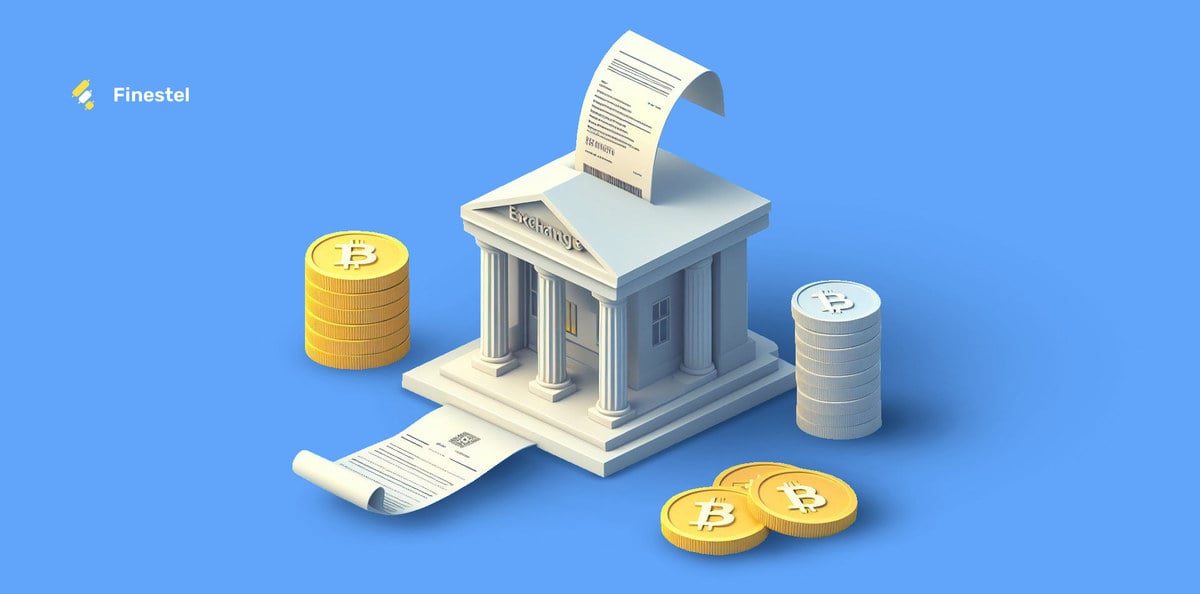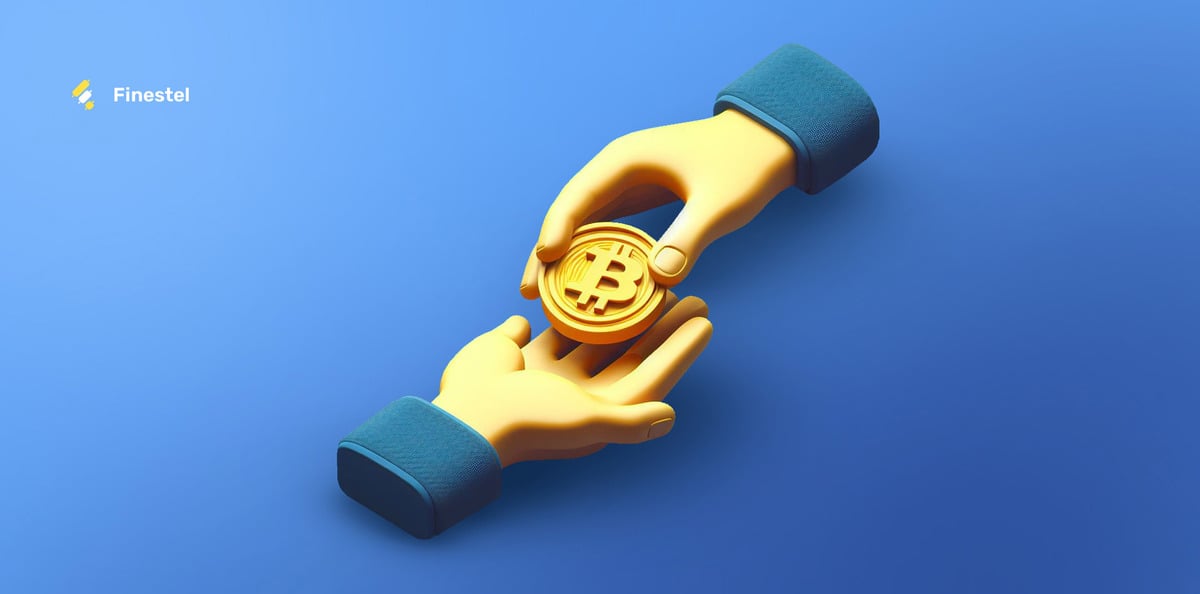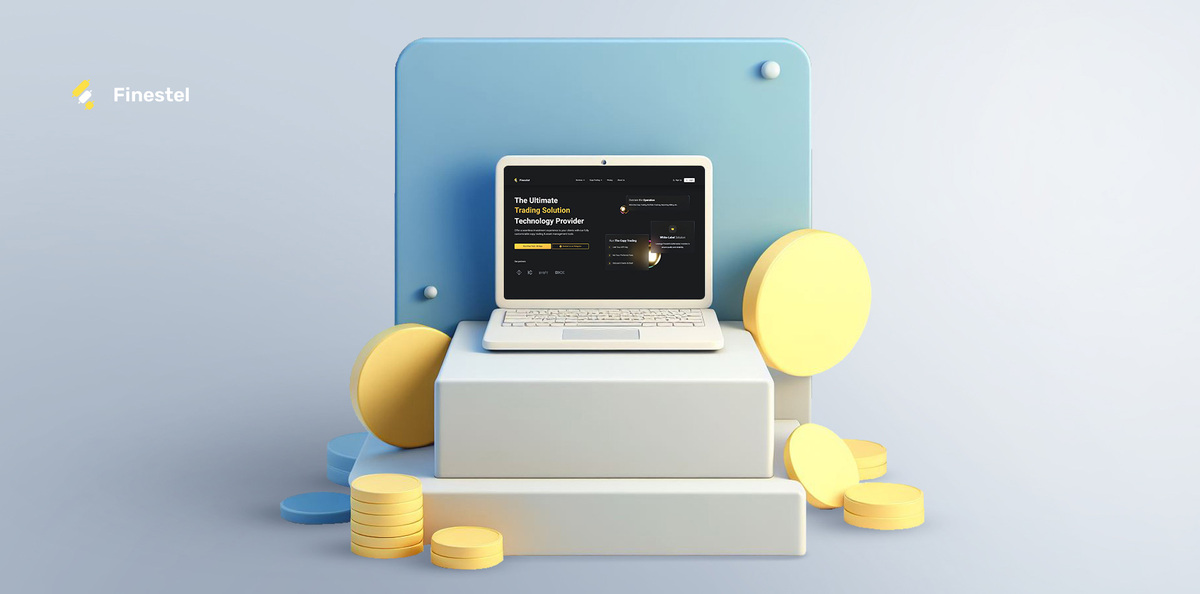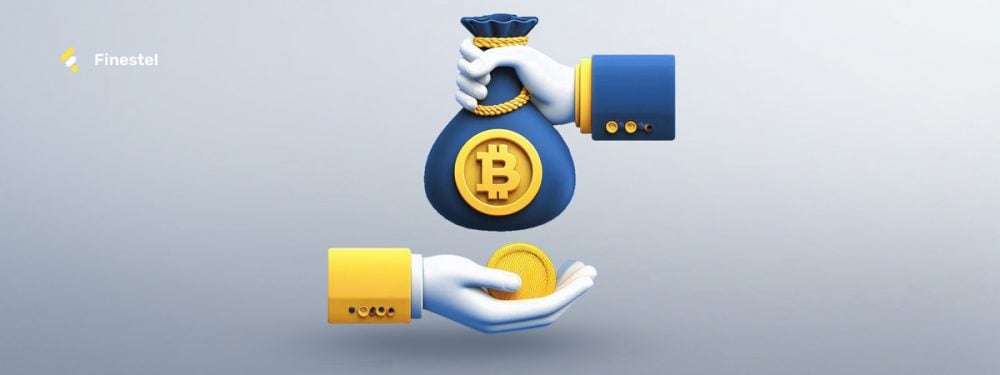In the wild world of crypto trading, where fortunes can be made or lost quicker than you can spell the word “Blockchain,” understanding maker vs taker fees is like having a secret weapon in your trading arsenal. Cryptocurrency exchanges play by a unique set of rules when it comes to fees and they are typically divided into two categories: maker and taker fees. Makers are the creators of market depth and liquidity, while takers are the executors of existing orders. Now, why does this matter? Because it’s essential to know how the market and order executions work for a professional trader.
In this article, we thoroughly analyze what maker and taker fees are, how they work, the differences between maker and taker fees, and how crypto exchanges structure their fees based on these two categories. Moreover, we evaluate maker and taker fees on some of the top crypto exchanges and introduce a few solutions regarding lowering these fees. Finally, we present Finestel’s innovative solutions for large asset management businesses and high-frequency traders to lower their maker and taker fees.
Introduction to Maker vs Taker Fees
In any financial market, there are typically two distinct categories of orders, makers and takers. Makers are the orders that make up the order book and provide liquidity. Limit orders are the primary makers. They can be buy or sell orders set at a specific price mark for a determined volume. You can monitor the limit orders via the exchange’s order book.

Taker orders, on the contrary, cannot be viewed before getting filled. They are instant orders, such as market orders, that are placed and filled instantly. For a market order to be executed, it matches the limit order at the nearest price mark, depending on the direction (whether it’s a buy or a sell). While maker orders are the ones that shape the market, takers are responsible for moving the price.
What Are Maker Fees?
You can think of makers as the architects of the market. They set limit orders at various price marks, showing their willingness to buy or sell a specific volume of the asset. In this case, when the maker order, which is typically a limit order, is filled, the trader will be charged a fee by the exchange. Yet, as an incentive for being patient and providing liquidity, maker fees are lower than taker fees.
Taker Fees Explained
Taker fees are charges for the impatient. If you are a taker, you do not want to wait for your order to get filled. Therefore, you execute a market order to match with one of the existing limit orders and it will be done almost instantly. Think of makers as the ones offering the orders and takers as the ones who take them. Unlike makers, takers are charged with a higher fee, as a result of their impatience and willingness to get filled quickly.
Maker vs Taker Fees on Top Crypto Exchanges
As a crypto trader, you are probably working with one of the top cryptocurrency exchanges. Therefore, it would be necessary for you to know about their maker vs taker fees and understand their fee structures. In this section, we analyze the fee structures of each of the top 5 crypto exchanges for both spot and perpetual futures trading.

Binance
Binance is the most renowned name in the crypto space. It is almost impossible for you to not have heard Binance’s name or even use one of its products as a cryptocurrency enthusiast, even if you are not a trader. Binance has the largest spot and futures markets among crypto exchanges. The fee structure on Binance is based on the monthly trade volume or your BNB balance, and being a maker vs a taker. Here is a breakdown of Binance’s maker and taker fees:
Spot Trading Fees
| Level | BNB Balance | 30-day Trade Volume | Maker / Taker |
| Regular User | ≥ 0 BNB | < $1,000,000 | 0.1000% / 0.1000% |
| VIP 1 | ≥ 25 BNB | ≥ $1,000,000 | 0.0900% / 0.1000% |
| VIP 2 | ≥ 100 BNB | ≥ $5,000,000 | 0.0800% / 0.1000% |
| VIP 3 | ≥ 250 BNB | ≥ $20,000,000 | 0.0420% / 0.0600% |
| VIP 4 | ≥ 500 BNB | ≥ $100,000,000 | 0.0420% / 0.0540% |
| VIP 5 | ≥ 1,000 BNB | ≥ $150,000,000 | 0.0360% / 0.0480% |
| VIP 6 | ≥ 1,750 BNB | ≥ $400,000,000 | 0.0300% / 0.0420% |
| VIP 7 | ≥ 3,000 BNB | ≥ $800,000,000 | 0.0240% / 0.0360% |
| VIP 8 | ≥ 4,500 BNB | ≥ $2,000,000,000 | 0.0180% / 0.0300% |
| VIP 9 | ≥ 5,500 BNB | ≥ $4,000,000,000 | 0.0120% / 0.0240% |
Futures Trading Fees
| Level | BNB Balance | 30-day Trade Volume | Maker / Taker |
| Regular User | ≥ 0 BNB | < $15,000,000 | 0.0200% / 0.0500% |
| VIP 1 | ≥ 25 BNB | ≥ $15,000,000 | 0.0160% / 0.0400% |
| VIP 2 | ≥ 100 BNB | ≥ $50,000,000 | 0.0140% / 0.0350% |
| VIP 3 | ≥ 250 BNB | ≥ $100,000,000 | 0.0120% / 0.0320% |
| VIP 4 | ≥ 500 BNB | ≥ $600,000,000 | 0.0100% / 0.0300% |
| VIP 5 | ≥ 1,000 BNB | ≥ $1,000,000,000 | 0.0080% / 0.0270% |
| VIP 6 | ≥ 1,750 BNB | ≥ $2,500,000,000 | 0.0060% / 0.0250% |
| VIP 7 | ≥ 3,000 BNB | ≥ $5,000,000,000 | 0.0040% / 0.0220% |
| VIP 8 | ≥ 4,500 BNB | ≥ $12,500,000,000 | 0.0020% / 0.0200% |
| VIP 9 | ≥ 5,500 BNB | ≥ $25,000,000,000 | 0.0000% / 0.0170% |
KuCoin
KuCoin is famous for its large variety of trading pairs available. There is a slim probability that you will find a cryptocurrency on other exchanges that is not listed on KuCoin. Therefore, it would be beneficial for crypto traders to be aware of KuCoin’s trading fees. Here is a complete breakdown of maker vs taker fees for KuCoin:
Spot Trading Fees
| Level | Total KCS Holding | 30-day Trade Volume | Maker / Taker |
| Lvl 0 | 0 | < 50 BTC | 0.100% / 0.100% |
| Lvl 1 | ≥ 1,000 | ≥ 50 BTC | 0.090% / 0.100% |
| Lvl 2 | ≥ 10,000 | ≥ 200 BTC | 0.070% / 0.090% |
| Lvl 3 | ≥ 20,000 | ≥ 500 BTC | 0.050% / 0.080% |
| Lvl 4 | ≥ 30,000 | ≥ 1,000 BTC | 0.030% / 0.070% |
| Lvl 5 | ≥ 40,000 | ≥ 2,000 BTC | 0.000% / 0.070% |
| Lvl 6 | ≥ 50,000 | ≥ 4,000 BTC | 0.000% / 0.060% |
| Lvl 7 | ≥ 60,000 | ≥ 8,000 BTC | 0.000% / 0.050% |
| Lvl 8 | ≥ 70,000 | ≥ 15,000 BTC | -0.005% / 0.045% |
| Lvl 9 | ≥ 80,000 | ≥ 25,000 BTC | -0.005% / 0.040% |
| Lvl 10 | ≥ 90,000 | ≥ 40,000 BTC | -0.005% / 0.035% |
| Lvl 11 | ≥ 100,000 | ≥ 60,000 BTC | -0.005% / 0.030% |
| Lvl 12 | ≥ 150,000 | ≥ 80,000 BTC | -0.005% / 0.025% |
Futures Trading Fees
| Level | Total KCS Holding | 30-day Trade Volume | Maker / Taker |
| Lvl 0 | 0 | < 200 BTC | 0.020% / 0.060% |
| Lvl 1 | ≥ 1,000 | ≥ 200 BTC | 0.015% / 0.060% |
| Lvl 2 | ≥ 10,000 | ≥ 400 BTC | 0.010% / 0.060% |
| Lvl 3 | ≥ 20,000 | ≥ 1,000 BTC | 0.010% / 0.050% |
| Lvl 4 | ≥ 30,000 | ≥ 2,000 BTC | 0.010% / 0.040% |
| Lvl 5 | ≥ 40,000 | ≥ 3,000 BTC | 0.000% / 0.040% |
| Lvl 6 | ≥ 50,000 | ≥ 6,000 BTC | 0.000% / 0.038% |
| Lvl 7 | ≥ 60,000 | ≥ 12,000 BTC | 0.000% / 0.035% |
| Lvl 8 | ≥ 70,000 | ≥ 20,000 BTC | -0.003% / 0.032% |
| Lvl 9 | ≥ 80,000 | ≥ 40,000 BTC | -0.006% / 0.030% |
| Lvl 10 | ≥ 90,000 | ≥ 80,000 BTC | -0.09% / 0.030% |
| Lvl 11 | ≥ 100,000 | ≥ 120,000 BTC | -0.012% / 0.030% |
| Lvl 12 | ≥ 150,000 | ≥ 160,000 BTC | -0.015% / 0.030% |
Bybit
Bybit is one of the most prominent crypto exchanges around the world. It caters to millions of traders from all around the world. The exchange is famous for its advanced derivatives platform but also has a large spot market. Bybit’s maker vs taker fee structure for spot and futures is presented below:
Spot Trading Fees
| Level | Asset Balance | 30-day Trade Volume | Maker / Taker |
| VIP 0 | ≤ 50K | 0 – $1M | 0.1000% / 0.1000% |
| VIP 1 | $50K | $1M – $2M | 0.0400% / 0.0600% |
| VIP 2 | $250K | $2M – $4M | 0.0250% / 0.0500% |
| VIP 3 | $500K | $4M – $6M | 0.0200% / 0.0450% |
| VIP 4 | $1M | $6M – $8M | 0.0150% / 0.0400% |
| VIP 5 | $2M | $8M – $10M | 0.0125% / 0.0350% |
| Supreme VIP | N/A | ≥ $10M | 0.0050% / 0.0200% |
| Pro 1 | N/A | $6M – $8M | 0.0150% / 0.0400% |
| Pro 2 | N/A | $8M – $10M | 0.0125% / 0.0350% |
| Pro 3 | N/A | $10M – $30M | 0.0100% / 0.0300% |
| Pro 4 | N/A | $30M – $60M | 0.0075% / 0.0250% |
| Pro 5 | N/A | ≥ $60M | 0.0050% / 0.0200% |
Futures Trading Fees
| Level | Asset Balance | 30-day Trade Volume | Maker / Taker |
| VIP 0 | ≤ 50K | 0 – $1M | 0.0200% / 0.0550% |
| VIP 1 | $50K | $10M – $25M | 0.0180% / 0.0400% |
| VIP 2 | $250K | $25M – $50M | 0.0160% / 0.0375% |
| VIP 3 | $500K | $50M – $100M | 0.0140% / 0.0350% |
| VIP 4 | $1M | $100M – $250M | 0.0120% / 0.0320% |
| VIP 5 | $2M | $250M – $500M | 0.0100% / 0.0320% |
| Supreme VIP | N/A | ≥ $500M | 0.0000% / 0.0300% |
| Pro 1 | N/A | $100M – $250M | 0.0100% / 0.0320% |
| Pro 2 | N/A | $250M – $500M | 0.0050% / 0.0320% |
| Pro 3 | N/A | $500M – $1,000M | 0.0000% / 0.0300% |
| Pro 4 | N/A | $1,000M – $2,000M | 0.0000% / 0.0275% |
| Pro 5 | N/A | ≥ $2,000M | 0.0000% / 0.0250% |
OKX
OKX is another popular cryptocurrency exchange. It has a deep market with massive liquidity and provides a user-friendly platform for traders. The spot trading fees are broken down with respect to customer level and being a maker vs a taker, but the futures fees are not presented in this article as they are very complex to explain conveniently. Therefore, you can take a look at OKX’s maker and taker fees below:
Spot Trading Fees
| Level | Total OKB Holding | Asset Balance | 30-day Trade Volume | Maker / Taker |
| Lvl 1 | < 100 | ≤ $100,000 | < $5,000,000 | 0.080% / 0.100% |
| Lvl 2 | ≥ 100 | ≤ $100,000 | < $5,000,000 | 0.075% / 0.090% |
| Lvl 3 | ≥ 200 | ≤ $100,000 | < $5,000,000 | 0.070% / 0.080% |
| Lvl 4 | ≥ 500 | ≤ $100,000 | < $5,000,000 | 0.065% / 0.070% |
| Lvl 5 | ≥ 1,000 | ≤ $100,000 | < $5,000,000 | 0.060% / 0.060% |
| VIP 1 | – | ≥ $100,000 | ≥ $5,000,000 | 0.060% / 0.050% |
| VIP 2 | – | ≥ $500,000 | ≥ $10,000,000 | 0.050% / 0.045% |
| VIP 3 | – | ≥ $2,000,000 | ≥ $20,000,000 | 0.030% / 0.040% |
| VIP 4 | – | ≥ $5,000,000 | ≥ $100,000,000 | 0.020% / 0.035% |
| VIP 5 | – | ≥ $10,000,000 | ≥ $200,000,000 | 0.000% / 0.030% |
| VIP 6 | – | – | ≥ $500,000,000 | -0.002% / 0.025% |
| VIP 7 | – | – | ≥ $1,000,000,000 | -0.005% / 0.020% |
| VIP 8 | – | – | ≥ $5,000,000,000 | -0.005% / 0.015% |
Gate.io
Gate.io is another top cryptocurrency exchange that is getting rather popular among crypto traders. The fee structure of their sport and futures trading platform depends solely on your 30-day trading volume. Gate.io maker vs taker fees are demonstrated in the table below:
Spot Trading Fees
| Level | 30-day Trade Volume | Maker / Taker |
| VIP 0 | $0 | 0.200% / 0.200% |
| VIP 1 | $60,000 | 0.185% / 0.190% |
| VIP 2 | $120,000 | 0.175% / 0.185% |
| VIP 3 | $240,000 | 0.165% / 0.175% |
| VIP 4 | $500,000 | 0.155% / 0.165% |
| VIP 5 | $1,000,000 | 0.145% / 0.155% |
| VIP 6 | $3,000,000 | 0.135% / 0.145% |
| VIP 7 | $8,000,000 | 0.125% / 0.135% |
| VIP 8 | $20,000,000 | 0.115% / 0.125% |
| VIP 9 | $50,000,000 | 0.105% / 0.115% |
| VIP 10 | $100,000,000 | 0% / %0.058 |
Futures Trading Fees
| Level | 30-day Trade Volume | Maker / Taker |
| VIP 0 | $0 | 0.015% / 0.050% |
| VIP 1 | $60,000 | 0.015% / 0.048% |
| VIP 2 | $120,000 | 0.015% / 0.046% |
| VIP 3 | $240,000 | 0.015% / 0.044% |
| VIP 4 | $500,000 | 0.015% / 0.042% |
| VIP 5 | $1,000,000 | 0.015% / 0.040% |
| VIP 6 | $3,000,000 | 0.010% / 0.038% |
| VIP 7 | $8,000,000 | 0.010% / 0.036% |
| VIP 8 | $20,000,000 | 0.010% / 0.034% |
| VIP 9 | $50,000,000 | 0.010% / 0.032% |
Maker Vs Taker Fee Comparison Between Top 5 Exchanges
We presented the fee structure for the top 5 exchanges in the crypto space. Yet, it would be beneficial for traders to also view a concise comparison of the maker and taker fees among these platforms. Therefore, we compare the fees of these exchanges at the normal user level in both spot and perpetual futures markets below.
| Exchanges | Spot | Futures | ||
| Maker | Taker | Maker | Taker | |
| Binance | 0.1000% | 0.1000% | 0.0200% | 0.0500% |
| KuCoin | 0.1000% | 0.1000% | 0.0150% | 0.0600% |
| Bybit | 0.1000% | 0.1000% | 0.0200% | 0.0550% |
| OKX | 0.080% | 0.100% | – | – |
| Gate.io | 0.200% | 0.200% | 0.015% | 0.050% |
Different Solutions to Reduce Maker vs Taker Fees
Reducing maker and taker fees on cryptocurrency exchanges is a common goal for traders seeking to optimize their profitability. Here are several solutions to consider:

- Tiered Fee Structures: Most exchanges offer tiered fee structures that reward frequent and high-volume traders with lower fees. By consistently trading on a platform, you can unlock reduced fees based on your trading activity.
- Automate or algo Trading: Using pre-programmed auto trading bots can provide more control and let you optimize order types/timing to take advantage of maker discounts. Bots don’t make emotional decisions.
- Native Exchange Tokens: Some exchanges have their own native tokens, and holding these tokens can often result in reduced fees. You can benefit from discounts by utilizing the exchange’s native token for transactions.
- Referral Programs: Referral programs offered by exchanges can provide users with reduced fees or other incentives for bringing in new users. The users invited by the affiliate can also enjoy reduced maker and taker fees. Read more about the best crypto affiliate programs.
- Promotional Periods and Special Offers: Exchanges often run promotional campaigns or special offers during which they may reduce or waive fees for a limited time. You can take advantage of these periods to lower their overall trading costs.
- Utilizing Maker Strategies: Since maker fees are generally lower than taker fees, you can focus on using strategies executed with limited orders. Being a market maker can help you reduce your trading fees considerably.
Finestel’s Solutions for Asset Managers and HFT Traders
Finestel is a leading trading technology solution provider and offers a variety of services. However, there are two primary services that we offer: copy trading as a service and white-label copy trading software. Finestel’s solutions, especially the white label plan can aid asset managers and high-frequency traders to manage their businesses efficiently by closely monitoring their clients and their portfolios, automating the billing procedure, and offering customized services. However, the benefits of utilizing Finestel’s platform do not end here.

Using Finestel’s services, you will have access to our cutting-edge portfolio tracker software. Therefore, you will not only be able to evaluate your trading strategies’ results and portfolio performance, but you will also have the ability to observe all your trading fees in one place. Therefore, you might be able to optimize your strategy to reduce your trading fees. For instance, using limit orders, when applicable, can be a game changer, as you will pay significantly lower fees as a maker.
Finestel’s portfolio tracker will provide you with sufficient data and insightful metrics, especially if you are an HFT trader and fees have a direct impact on whether you are able to generate sustainable profits or not. The produced information can help you make subtle tweaks to your strategy and considerably boost your profitability. So, if you are an asset manager or HFT trader, tired of paying a huge chunk of your gains back to the exchange, contact us right now. Join Finestel and we promise, you will never look back.
Conclusion
In this article, we introduced you to the concept of maker vs taker fees. We thoroughly explained each fee category, presented the fundamental distinctions, and demonstrated the resulting differences in the amount of fees you will pay. Furthermore, we analyzed the top 5 crypto exchanges’ fee structures. We stated how fees vary based on whether you are a market maker or a taker. We also presented are also other metrics like monthly trading volume and total asset balance that play a considerable part in the fees you pay on these exchanges.
Finally, we briefly introduced Finestel’s services, copy trading as a bot service and the white label asset management software. We explained how asset managers and high-frequency traders can benefit from the tools we offer, especially the portfolio tracker. It can help traders measure their trading fees easily look for patterns and generate ideas to cut these fees. Consequently, you will save a lot of profits in the long run.





Leave a Reply